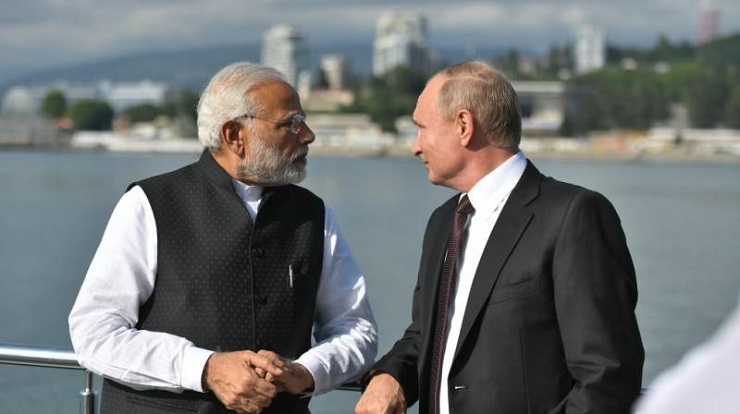The dictum that ‘there are no permanent friends and no permanent enemies’ in the global system means, in simple words, that geopolitical alignments are never static or frozen into a permanent state of affairs and that the process of realignment remains ongoing. Nowhere is this shift perhaps more obvious today in our part of the world i.e., Asia than in India’s clear bid to wade into Eurasia. This is happening not just because India’s relations with Russia go way back many decades, but mainly because of a deep rupture between India-US bilateral relations which have suffered at the hands of US president Trump’s aggressive, self-asserting economic and trade regime vis-à-vis other countries, including India. President Trump’s imposition of tariffs and the revocation of India’s special status has put India in the same category of countries for the US as China, for instance. India has responded by imposing its own tariffs and if the US hits back, it will probably use Section 301 of the Trade Act. This is the same mechanism Trump used to levy tariffs on Chinese products.
It is thus the US itself that is unwittingly creating conditions to enable India and China to form a strategic alliance, potentially integrating the emerging Eurasian geopolitics led in part by Russia aimed at creating a multipolar world and not only end the US dollar’s monopoly over the global economic system but also US unilateralism it continues to increasingly display in both economic and strategic realms of world politics.
Its clear manifestation was, first of all, in the recently held SCO summit in Bishkek where India, in a first move of this kind, made no reference to China’s BRI and/or CPEC at any level, making a significant departure from its previous criticism of the Chinese projects. While silence on BRI doesn’t mean its acceptance, what India did and Xi agreed was to give China-India economic relations an even more robust bilateral injection with the aim of making their bilateral trade volume the biggest in the entire world. Modi also met Putin and their meeting reaffirmed their traditionally strong ties, developing stronger under the shadow of the S-400 missile defence system deal, a deal that the US continues to oppose and sees as potentially bad for their relations with India.
These developments are significant in geopolitical terms. Significant enough to merit US Secretary of State Mike Pompeo’s ‘corrective’ diplomatic mission to India just ahead of the G-20 summit in Japan. The purpose of his visit was to prevent India from wading into Eurasia. The outcome has been, as was highly expected, an even greater Indian push for integration with Eurasia. Of course, the Indians refused to cancel their S-400 deal, sticking instead to the needs of their own national interests, expecting instead the US to respect these interests.
The meeting obviously failed to ‘correct’ India’s behavior, a fact that president Trump wasted no time to mention in his tweets where he said India’s imposition of tariffs on US products was “unacceptable” and demanded their removal.
While India is unlikely to continue to pay unconditional attention to the US’ endless demands (starting with India’s acceptance of US sanctions on Iran and halting its purchases of oil from Iran), the locus of Indian assertiveness is to be found in Eurasian integration, a process that India’s foreign minister described during the SCO summit as the defining feature of the 21st century and a necessary component of their own role in the Asia-Pacific region. The reference to Indo-Pacific against the backdrop of redefined India-China relations is highly significant in that in the US’ own Indo-Pacific strategy, India has a role to play in the ‘containment of China.’ India is obviously in the middle of redefining its relations with China in a way that ‘containment’ would no longer be an option.
Again, India’s growing closeness with China and its increasing distance from the US throws significant light on how the US is losing the game. Needless to say, Modi’s meeting with Trump on the sidelines of the G-20 summit failed to generate any breakthrough. Ivanka Trump limited her words to describing this meeting as a “productive conversation.”
The real action, however, took place in a trilateral meeting between Xi, Putin and Modi. This is where Modi’s real disposition vis-à-vis the US was in full swing. In his remarks, he stressed the multilateral effort to fight climate change, and complained that the global economy is being ruled by a “one-sided” dictate, emphasizing the necessity to reform the World Trade Organization.
For Putin, with Russia being under US sanctions, calls for conducting trade in bilateral currencies is essential for fighting “protectionism.” As far as India’s interests are concerned, this is a significant call in that it can enable it to bypass and avoid US sanctions if it wants to continue buying oil from Iran and thus maintain or even strengthen its grip over Chabahar Port, a project that is very significant for India in terms of its own bid to have direct access to Central Asia and Afghanistan.
The bid to bypass SWIFT is not a fantasy. Alternative systems already exist and countries like India, which are directly affected by US sanctions, might be tempted to use the Russian System for Transfer of Financial Messages (SPFS) and the Chinese Cross-Border Inter-Bank Payments System (CIPS).
There is thus a strong “lure” for India in the geopolitics and geoeconomics emerging from Eurasia and displaying a potential of becoming a global system in the future. While it is in the hands of Modi to decide which geoeconomic swing of the pendulum to favor, the above discussed developments clearly point to a preference for Eurasia. Only time will tell whether or not he is using it as bait to lure the US into treating India a bit differently.
Salman Rafi Sheikh, research-analyst of International Relations and Pakistan’s foreign and domestic affairs, exclusively for the online magazine “New Eastern Outlook”.

